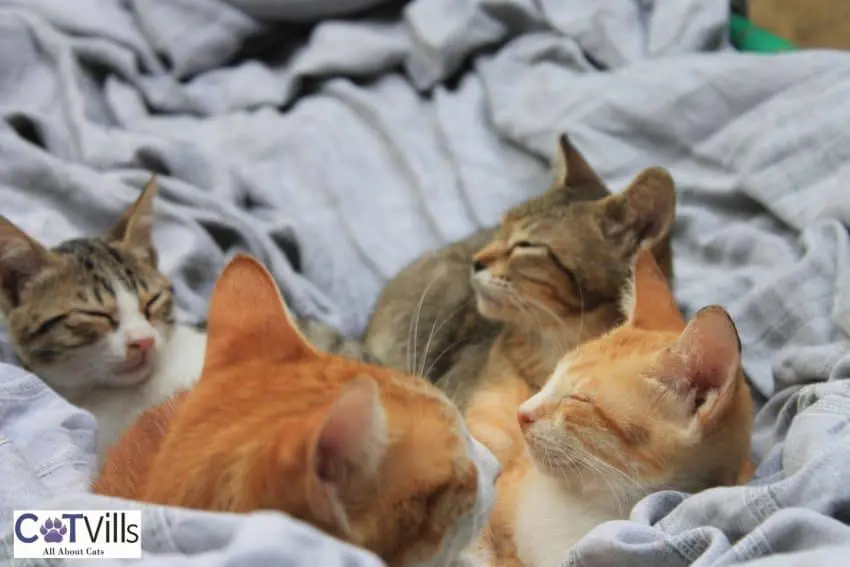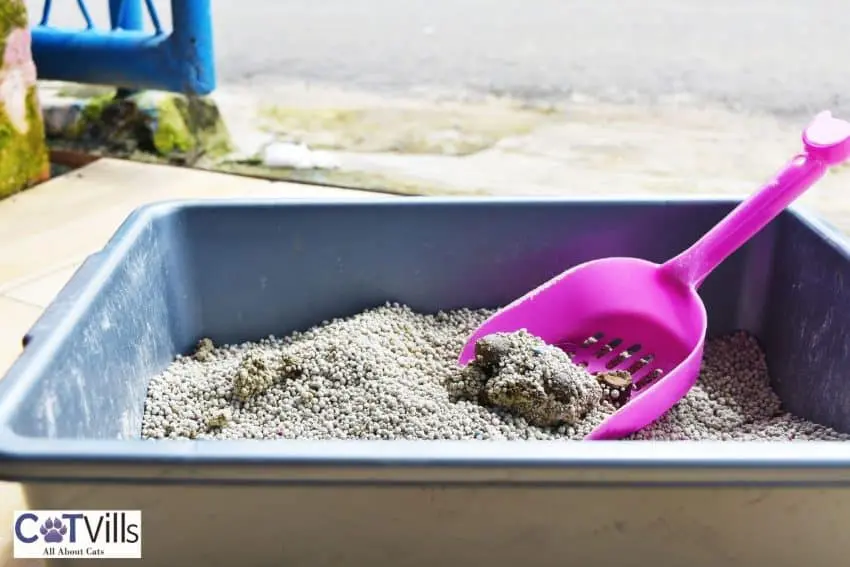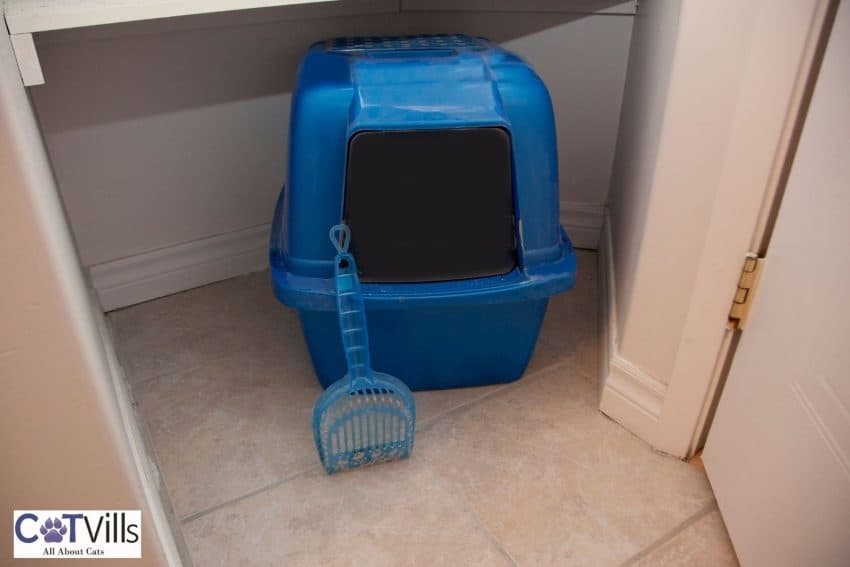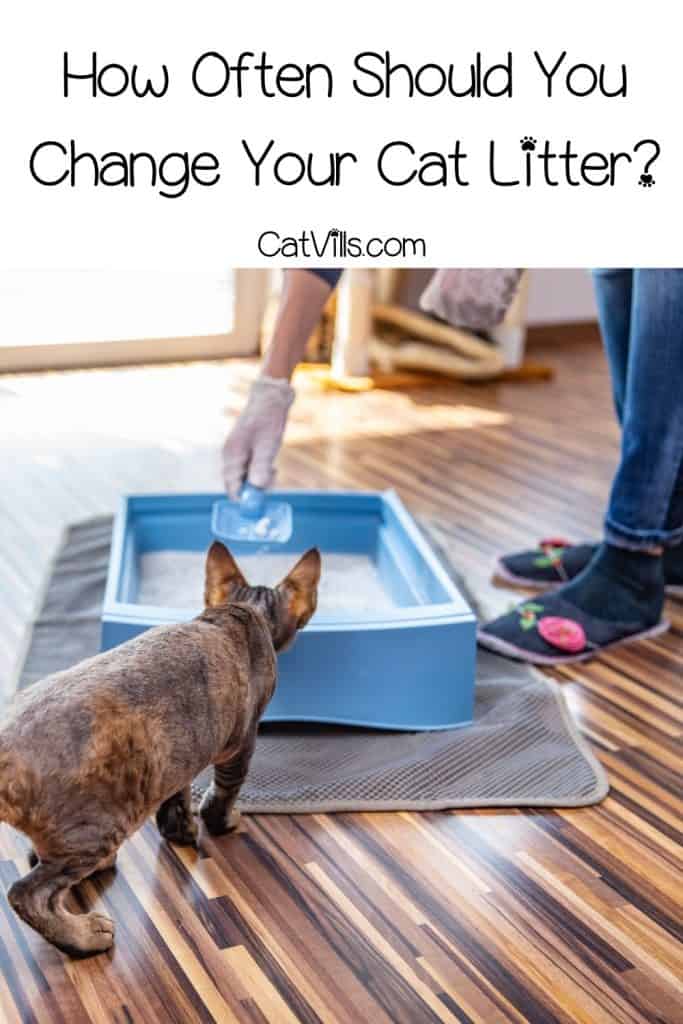Last Updated: 4 months ago
Don’t worry, this is an issue that many cat parents struggle with.
The answer depends on several factors, such as the type of litter you use and the number of cats in your household.
As a cat mom or dad, you want to keep your kitty’s litter box as clean as possible. However, it is often challenging to find time to scoop and change the litter daily.
We understand your struggles. We encountered the same problems when we had a new cat. We weren’t aware of what to consider before changing my feline friend’s litter.
But we quickly learned and want to share our tips with you.
Factors That Affect Cat Litter Changing/Scooping

The good news is that with good daily maintenance, you don’t have to do it every day.
How often to change cat litter and how often you need to scoop depends on the following factors.
#1 Number of Cats

Our feline friends usually poop at least once per day and pee two to three times daily. Therefore, a cat will use a litter box at least three times a day depending on the following:
- Her health condition
- Average fluid intake
- The temperature in your house
- Her age
If you have more than one cat in your household using the same litter box, you’ll have to change or scoop the litter more frequently.
This is because the waste products of multiple cats will quickly fill up the box and make it dirty. I noticed that a dirty cat litter box causes odor in the house due to ammonia from the urine.
It also attracts bugs, such as flies and cockroaches. A dirty litter box may lead to complications like feline UTIs.
On the other hand, if you only have one kitty at home, you can extend the duration between changing or scooping the litter. However, keep an eye on it to see if it’s dirty and needs changing.
#2 Type of Litter Used

The right type of litter will give you more time between the changes.
For instance, if you use a clumping litter, you don’t need to do it as frequently as you do when using non-clumping litters.
Clumping cat litters are excellent at absorbing urine and forming clumps. The clumps prevent cat waste from spreading throughout the entire litter tray.
Silica gel crystals also absorb urine. The crystals will clump together when they make contact with moisture, making it easy to remove the solid waste by scooping instead of changing the litter.
I’ve been using clumping litter for my cat. I find it more efficient because it traps unpleasant odors and allows me to only scoop out waste without changing all the litter.
Also, some vets suggest that many cats “prefer fine particle, clumping clay litters,” as the “finer particle feels better on their paws.”
#3 Indoor Vs. Outdoor Cat
An indoor cat will use the litter box more frequently than an outdoor feline friend. This is because an indoor kitty doesn’t have anywhere else to relieve herself.
An outdoor cat will only use the litter box when it’s raining or cold outside. Your feline friend will do its business in the garden or anywhere else outside the rest of the time.
With an indoor cat, you’ll have to scoop or change the litter more frequently compared to an outdoor cat.
You must also consider if your cat is spayed or neutered. Male cats that are not neutered will spray urine around the house to mark their territory. This will make the litter box dirtier quickly and cause a foul odor in your home.
How Often Should You Scoop Your Cat Litter?

You need to scoop the litter box each time your cat uses it. This means you’ll be scooping it twice daily if your cat uses it once in the morning and once at night.
A rule of thumb is always to scoop the litter daily. Keeping the litter box clean is one way of encouraging your cat to use it.
The goal is to remove any soiled litter that may prevent your cat from using the box. Top up the box with fresh litter after every scoop.
How Often Should You Change Your Cat Litter?
The short answer is that it depends on many of the factors that I’ve just discussed. Each of these will affect how often you should scoop and change your cat’s litter.
However, a rule of thumb is to change your kitty litter and clean it thoroughly every 2-4 weeks.
Clumping and Non-clumping Litter

These are the two main types of cat litter. Clumping litter is where the waste, mainly urine, clumps together.
This makes it easy to scoop out the clumped waste without changing the entire content of the litter box.
How often to change clumping litter? A good approach is to do it monthly because if it overstays, it will harbor fleas and bacteria.
Non-clumping litter, on the other hand, doesn’t form clumps when in contact with moisture. Once it’s soiled, the entire content will need changing since you can’t scoop out only the waste very easily.
How often should you change non-clumping cat litter? Do it every 1-2 weeks because this litter absorbs cat urine and does not clump.
What if You Don’t Change Your Cat Litter?

Two things will happen if you don’t change your cat’s litter box.
- She’ll hold it in until the litter is changed
- She’ll go somewhere else.
If your cat holds in her urine or poop for long, she’s at risk of developing a urinary tract infection (UTI). The bacteria in her waste will recirculate back to her body through the urethra.
A second possibility is that your cat will go outside the cat toilet and relieve herself wherever she pleases. She may choose to do her business on your favorite rug or carpet. You definitely don’t want that!
There are also various dangers of cat litter to humans. A good example is toxoplasmosis infection.
How to Make Your Cat Litter Last Longer
- Use the right size litter tray for your cat: A general rule is one-and-a-half times the size of your kitty and the same width as the length of your feline. A larger sandbox means more surface area for your cat to use.
- Use a slotted scoop: This will allow the clean, loose litter to fall back into the tray.
- Place a mat under the litter box: A good quality mat will help catch any stray pieces of litter that your cat may track outside the box. This prevents litter from being scattered around your home.
- Scoop the cat toilet daily: This will help to remove any soiled litter before it has a chance to build up and make the box dirtier quickly.
- Change the entire content of the sandbox every two to four weeks: If you’re operating on a tight budget, look for the cheapest place to buy cat litter.
- Consider getting a Litter-Robot: A self-cleaning cat toilet will remove waste after each use, preventing extra litter from building up into clumps during the day.
How Often Should You Clean Your Cat’s Litter Box?
It’s recommended to clean your cat’s tray monthly. However, the cleaning frequency depends on the number of kitties using it and the type of tray, either clumping or non-clumping.
If you have more than one cat using the box, increase the cleaning frequency to fortnightly or weekly.
When Should You Replace Your Old Litter Box?

A general rule is to replace your cat’s litter box yearly. However, you should replace it when you see cracks, chips, or fading, even if it has not served you for a year.
Replacing an old litter box will help keep your cat healthy since it’s easier to clean and disinfect a new one.
Moreover, a new litter box prevents your cat from tracking outside through cracks.
Safe Ways to Dispose of Cat Litter
You may be tempted to flush cat poop because you’re tired of cleaning the litter box. It is best to avoid this.
Cat waste is not the same as human waste. Cat poop comprises sodium bentonite, which expands up to 15 times its size when exposed to moisture.
The component also hardens when exposed to water. The consequence of this is plumage blockage.
Moreover, septic systems don’t kill the Toxoplasma Gondii parasite in cat feces. These parasites may end up infecting you and other family members.
To dispose of cat litter safely, follow the below procedure:
- Use a litter scoop to sift through the sand and remove any waste.
- Put the scooped waste in a plastic trash bag.
- Tie the plastic bag tightly to prevent leakage and throw it in the trash can with a tight-fitting lid.
- Wash your hands thoroughly with soap and water after disposing of the cat litter.
Alternatively, seal the poop in a biodegradable bag and dispose of it in the trash. If you use biodegradable litter like wheat, pine, and corn use a compost pit placed away from your garden.
Expert Tip: Do not scoop cat poop into a trash can a let it stay there. Apart from becoming stinky after some time, contaminated cat poop can get into the air when the can is opened.
Useful Tips for Cleaning the Cat Litter Box
Cleaning a cat’s litter box requires an effective routine. Use the following cleaning process every time you want to clean your kitty’s sandbox.
- Put on gloves and a mask: This protects you from bacteria.
- Empty the box after scooping the litter: The litter must be scooped daily.
- Wash the litter box: Use soap, a rag, and warm water to clean the sandbox.
- Deodorize: Use baking soda to deodorize the box after rinsing it with hot water.
Use a mild detergent like Ecover and Dishmate and not bleach or any other harsh chemicals.
Apart from being comfortable for your cat’s use, a clean litter box will not cause odors in your house.
Conclusion
Changing your cat’s litter depends on the number of cats using it, the type of litter, and whether your cat is an indoor or outdoor one.
A general rule is to change your cat’s sandbox every 2-4 weeks. Now that you know how often to change cat litter, put on your gloves and mask as a cat parent and get to work.
How often do you change your cat litter? Do you have your methods of changing? Please share with us down in the comment section!
Resources:


Olfa knows how to get things done and has a keen business sense that others admire. She’s always on the go, coming up with new ideas! Her ability to anticipate the needs of her readers and deliver information that they want is what makes CatVills such a success. She loves cuddling her cat Picaciu. He is her inspiration.
